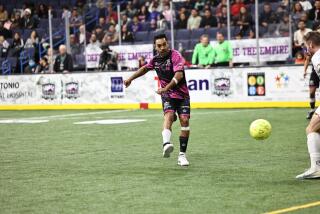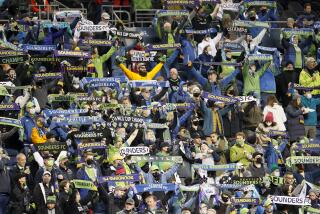Despite an Official New Start, Sockers Will Be Sockers
- Share via
Sometime Saturday night at the Sports Arena, a milestone in the history of the Sockers will be attained.
The first player to score a goal in the season-opener against the Los Angeles Lazers will be the Sockers’ new career scoring leader.
It will not be Juli Veee, but it might be Branko Segota.
It will not be Jean Willrich, but it might be Paul Dougherty.
It will not be Kaz Deyna, but it might be Poli Garcia.
You see, Juli Veee, Jean Willrich and Kaz Deyna do not exist anymore. At least technically.
These are the new Sockers, who are entering what might be called The Modern Era. Anything that has gone before is relegated to the archives, as in ancient history. The old Sockers are being left for archeologists to someday unearth.
As you probably have figured, it has to do with the bankruptcy of the past spring and summer and the fact that Ron Fowler purchased what amounted to a new franchise out of that bankruptcy. Forget that Fowler was also a part of the previous ownership. This is not the same franchise, at least technically.
“We bought out certain assets, such as the name, and certain contracts,” explained President Ron Cady, “but we didn’t buy the records.”
Good thing. They probably would have been too expensive. This club has set standards that no franchise hereabouts is likely to approach, what with 6 indoor championships in the last 7 years. The memories have been golden.
And maybe that is the bottom line.
Everyone in the cozy world of indoor soccer knows what the Sockers have done, and these Sockers will always be the Sockers in their minds. Neither the Major Indoor Soccer League nor a bankruptcy court can erase memories.
“Nobody,” said defender Kevin Crow, “will ever forget what we’ve done in the past. We have to build on that . . . and continue.”
Presumably, the 6 championship banners were among the “certain assets” purchased, because the first 5 will be hanging in the rafters Saturday, and the sixth will be raised in a pregame ceremony. If anyone should complain that they represent accomplishments from a different age or a different franchise, then we’ll just call ‘em draperies . . . but Socker fans will know what they represent.
There’s something else you should know about these new Sockers. They are an awful lot like the old ones.
Ron Newman is still the coach.
Branko Segota is still the shooting star.
Kevin Crow is still a defender of Olympic skills, literally.
Brian Quinn is still the scrappiest midfielder this side of Tim Flannery, whose work ethic he shares.
Jockey-sized Paul Dougherty is still on his high horse.
Zollie the goalie is still the Toth of the town.
And darned if the smoke and red carpet and fanfare will not once again accompany the introductions.
The untrained eye might not even realize that these are not the Sockers of old. There have been transition years before, such as the year when it seemed half the franchise was sold to Las Vegas.
This year’s turnover--Juli Veee, Jim Gorsek, Fernando Clavijo and Hugo Perez are the missing links--is really less extreme than when Veee, Alan Mayer, Martin Donnelly, Gert Wieczorkowski and Lorenz Hilkes departed during or after the 1983-84 season. Those guys were all mainstays on championship teams.
In this transition year, the Sockers have done their usual job of filling gaps with acquisitions that would be considered steals if Jack McKeon pulled them off. Guys such as Alan Willey, Chris Chueden, Ralph Black, Gary Etherington and Victor Nogueira are established indoor players.
“With the players we’ve brought in,” Quinn said, “there are no question marks. All we have to do is adapt them to our system.”
The biggest thing this franchise must fight is this impression that it does not exist anymore. The bankruptcy and the tenuous nature of the MISL’s existence over the summer could well have left some nasty perceptions that the sport is back in a diluted way.
Far from it. Only 7 of last season’s 11 teams survived the summer’s trauma, leaving the same number of quality players to be stirred into fewer pots.
“We have theoretically improved our team,” Newman said. “We still have Segota, Karic, Keder and Quinn, and we’ve added Alan Willey. That’s some formidable offensive power. But I don’t think we’ve improved our chances because the other teams have improved even more.”
And so these new, if you insist, Sockers stand on the brink of a season many thought would never exist. They already have established a common link with their predecessors, which is to say they already have shown the resilience to overcome adversity.
In fact, about all that’s missing is the tumult and the pouting and the controversy that has made this group so colorful.
“We have no controversy,” Newman said. “No backbiting. Nobody’s calling me names.”
He hesitated and scratched his head.
“I guess I should be worried about the state of the team,” he said. “Everybody’s too polite to be healthy.”
Indeed, they all showed up in coats and ties and smiles for a luncheon Wednesday. Being the Halloween time of year, maybe they were in costume.
The real Sockers will be there Saturday night. Not the old ones. Not the new ones. The real ones.
And that has always been good enough.
More to Read
Go beyond the scoreboard
Get the latest on L.A.'s teams in the daily Sports Report newsletter.
You may occasionally receive promotional content from the Los Angeles Times.










